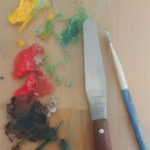
If you ever spend much time time around an artist I’m sure you’ll hear them mumble ‘Trust the process damnit’ to themselves. But as a developing artist you quickly find yourself wondering “What Process?!!? How do I get a process that I can trust??!”
And if you take a course from an artist, or watch a bunch of YouTube or whatever process you can learn from, you’ll run across tons and TONS of artists who are more than happy to talk about ‘the right way to do X’. And if you’re like me, some of it will be amazing knowledge, and even more of it will be nonsense. Which brings us back to the whole process thing. What a lot of teachers try to teach you are their process, or the process of classical artists. That’s useful information, but what it doesn’t do is give you YOUR process.
Your process can’t be taught to you by someone else, you have to un-earth it yourself because no teacher, no matter how great they are, is YOU, and your process is yours, not theirs.
What a good teacher does is explain WHY their process works for them, what problem each step is meant to give a solution for, be it proportion, anatomy, composition, line, shape, whatever!
So as a student, it’s your goal to TRY their process, and see how much of it fits. I promise you that not all of it will, if you’re lucky then a lot of it will, but it may not, and you have to realize THAT is OK. What you’re learning, even if you don’t like doing their steps, is how they think. And like most knowledge, learning how to think around problems lets you help define the problems and come up with your own answers.
And once you can recognize the problems you encounter over and over (how do I render form, how do I draw the viewers eye, how do I suggest love, life, motion whatever) then you can use all the different answers that teachers have given you to how THEY solved those problems, and come up with what works for you. Stack those answers end to end and before long you can go from idea to finished piece again and again.
And once you have that my friend… then you’ve got a process. It’s yours and you’ll refine and hone it for the rest of your life, and maybe try to explain it to other artists. It may not work for anyone other than you, that’s OK, because it works for YOU.
To bring it full circle, once you know your process, you know what comes next. Even though you might be stuck in the ugly phase of a piece, you know that it doesn’t stay that way because the next step is coming up and you have an understanding of what problems that will resolve, or you know what the previous step was and you can always go back and course correct. To everyone who doesn’t know your process it looks like magic, but you know that all you’re really doing is trusting the process you’ve created for yourself. And if you find yourself saying, “But I don’t want a process I want to Floooow and art just appear”, just recognize that once you have the process, it means you’re not trying to problem solve all the big concepts, and for the first time you’re finally free to play and create because the process takes care of the boring parts.
Now go and make something uniquely yours!


